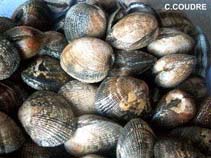Ruditapes decussatus (Linnaeus, 1758)
Grooved carpet shell| Native range | All suitable habitat | Point map | Year 2050 |

|
| This map was computer-generated and has not yet been reviewed. |
| Ruditapes decussatus AquaMaps Data sources: GBIF OBIS |
Classification / Names Tên thường gặp | Các synonym ( Các tên trùng) | CoL | ITIS | WoRMS
Bivalvia | Venerida | Veneridae
Environment: milieu / climate zone / Mức độ sâu / distribution range Sinh thái học
; Thuộc về nước lợ; Mức độ sâu 0 - 1 m (Tài liệu tham khảo 105875). Tropical, preferred 15°C (Tài liệu tham khảo 107945); 61°N - 13°N, 18°W - 36°E
Distribution Các nước | Các khu vực của FAO | Các hệ sinh thái | Những lần xuất hiện | Những chỉ dẫn
Eastern Atlantic and Mediterranean: from Norway to United Kingdom, France, Spain, Portugal, Morocco, Mauritania, and Senegal, including the Mediterranean, from Spain, France, Monaco, Italy, Slovenia, Croatia, Bosnia and Herzegovina, Montenegro, Albania, Greece, Turkey, Cyprus, Syria, Lebanon, Israel Egypt, Libya, Tunisia, and Algeria. Introduced in Azores Islands. Temperate to tropical.
Length at first maturity / Bộ gần gũi / Weight / Age
Chín muồi sinh dục: Lm ? range ? - ? cm Max length : 8.0 cm SHL con đực/không giới tính; (Tài liệu tham khảo 109255); common length : 6.0 cm SHL con đực/không giới tính; (Tài liệu tham khảo 437)
Life cycle and mating behavior Chín muồi sinh dục | Sự tái sinh sản | Đẻ trứng | Eggs | Sự sinh sản | Larvae
Main reference
Các tài liệu tham khảo | Người điều phối | Người cộng tác
SAUP Database. 2006. (Tài liệu tham khảo 356)
IUCN Red List Status
(Tài liệu tham khảo 130435: Version 2024-2)
CITES status (Tài liệu tham khảo 108899)
CMS (Tài liệu tham khảo 116361)
Threat to humans
Human uses
Các nghề cá: Tính thương mại
FAO - Nuôi trồng thủy sản: production, species profile; Các nghề cá: landings, species profile | FishSource | Biển chung quanh ta
Các công cụ
Thêm thông tin
Max. ages / sizes
Length-weight rel.
Length-length rel.
Length-frequencies
Mass conversion
Sự phong phú
Các nguồn internet
BHL | BOLD Systems | CISTI | DiscoverLife | FAO(Nuôi trồng thủy sản: species profile; Các nghề cá: species profile; publication : search) | Fishipedia | GenBank (genome, nucleotide) | GloBI | Gomexsi | Google Books | Google Scholar | Google | PubMed | Cây Đời sống | Wikipedia (Go, tìm) | Tạp chí Zoological Record



